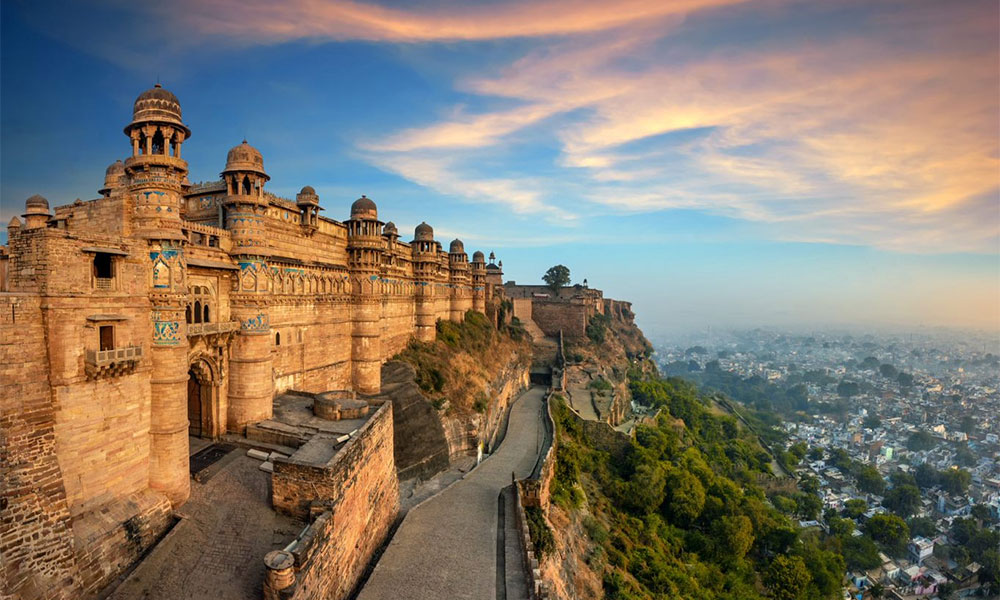The fort comprises of two main doorways – South West and North East gates. It houses interesting and enthralling historical sites. The fort also contains palaces, temples as well as many water tanks. Furthermore, the southern pathway is encompassed by sophisticatedly chiseled rock faces which are inspired by Jain Tirthankars.
Gwalior Fort is a majestic hilltop fortress located in the city of Gwalior, in the state of Madhya Pradesh, India. The fort is one of the most significant historical landmarks in the region and holds immense architectural, cultural, and historical importance.
Gujari Mahal
Gujari Mahal, which is also a famous museum, is considered as one of the admirable monuments of Gwalior. Raja Mansingh constructed this exquisite structure for his beloved Queen Mrignayani in the 15th century. The palace houses a sculpture of the tree goddess Gyraspur Shalabhanjika who is regarded as the embodiment of supremacy in miniature. A noteworthy feature of the palace is the treasured crown with fine jewels and stones ornamentation. The palace has voluminous assortment of sculptures from 1st century AD.
Located within the premises of the colossal Gwalior Fort, the archaeological museum conserves ancient treasures and striking sculptural gems. The aerial view of this amazing museum boasts of the charismatic architecture of the Gujari Mahal. This enamoring stone structure houses weaponry, stone-work relics, bronze artifacts, and devotional statues. The portrayal of Lord Vishnu’s head and Lord Krishna’s birth bespeaks the exceptional finesse of the craftsmen of that era. The leading attraction of the fort is the statue of the Indian Mona Lisa and the sculpture of Gyraspur Shalabhanjika.
Sahastrabahu Temple
Sahastrabahu Temple or Sas Bahu Temple is situated on the east of Gwalior Fort. Constructed by King Mahipala of the Kachchhapaghata Empire in 1092, the temple is one of the outstanding architectural wonders located close to Gwalior Fort. The 32-meter long temple has three major entrances positioned at three different directions. The entire temple is embellished with carvings, noticeably 4 idols of Vishnu, Saraswati, and Brahma atop its entrance door.
Sas Bahu temple
The Sas Bahu temple in the fort does not only entice the devotees but also the tourists with an affinity for artistic value. The temples are located in close proximity to each other and are identical in style. The bigger one is extensively adorned with marvelous carvings and sculptures of the god. The ceiling of the larger temple is embellished with a graceful lotus carving which looks incredibly enchanting.
Jai Vilas Palace
Jai Vilas Palace was built by Maharaja Jayaji Rao Scindia at the cost of 1 crore in 1874. The palace illustrates a classic example of European architecture, the design of which was conceived by Sir Michael Filose. An amalgamation of different architectural styles, the first level is Tuscan, the second is Italian-Doric and the third story is constructed in Corinthian style. The palace is sprawled over an area of 12, 40,771 square feet and is remarkably known for its massive Durbar Hall. The interiors of the palace are adorned with gold and ostentatious furnishings coupled with enormous chandeliers and a large carpet. It stands at a height of 41 feet and is over 50 feet wide and 100 feet long.
Book a tour package to Gwalior and prepare to live it up in this magnificent city. At India Holiday Mall, we have created a variety of tour packages for your tour to Gwalior and various other destinations in the country. Check with us to know about the current exciting deals that are waiting to be snapped up!
